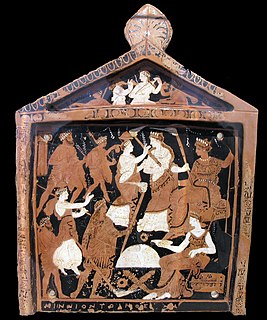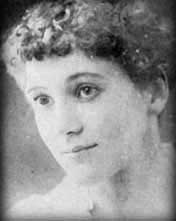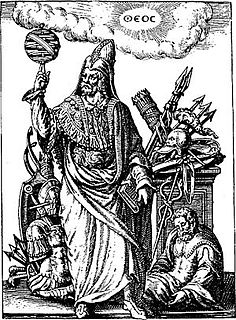
Aleister Crowley was an English occultist, ceremonial magician, poet, painter, novelist, and mountaineer. He founded the religion of Thelema, identifying himself as the prophet entrusted with guiding humanity into the Æon of Horus in the early 20th century. A prolific writer, he published widely over the course of his life.

The Hermetic Order of the Golden Dawn was a secret society devoted to the study and practice of the occult, metaphysics, and paranormal activities during the late 19th and early 20th centuries. Known as a magical order, the Hermetic Order of the Golden Dawn was active in Great Britain and focused its practices on theurgy and spiritual development. Many present-day concepts of ritual and magic that are at the centre of contemporary traditions, such as Wicca and Thelema, were inspired by the Golden Dawn, which became one of the largest single influences on 20th-century Western occultism.
Magick, in the context of Aleister Crowley's Thelema, is a term used to show and differentiate the occult from performance magic and is defined as "the Science and Art of causing Change to occur in conformity with Will", including "mundane" acts of will as well as ritual magic. Crowley wrote that "it is theoretically possible to cause in any object any change of which that object is capable by nature". John Symonds and Kenneth Grant attach a deeper occult significance to this preference.

Thelema is a social or spiritual philosophy developed in the early 1900s by Aleister Crowley, an English writer, mystic, and ceremonial magician. The word thelema is the English transliteration of the Koine Greek noun θέλημα, "will", from the verb θέλω (ethélō): "to will, wish, want or purpose".

Liber AL vel Legis, commonly known as The Book of the Law, is the central sacred text of Thelema, allegedly written down from dictation mostly by Aleister Crowley, although his wife Rose Edith Crowley is also known to have written two phrases into the manuscript of the Book after its dictation. Crowley claimed it was dictated to him by a preternatural being calling himself Aiwass, but the three chapters are largely written in the first person by the Thelemic deities Nuit, Hadit, and Ra-Hoor-Khuit respectively.

The Eleusinian Mysteries were initiations held every year for the cult of Demeter and Persephone based at Eleusis in ancient Greece. They are the "most famous of the secret religious rites of ancient Greece". Their basis was an old agrarian cult, and there is some evidence that they were derived from the religious practices of the Mycenean period. The mysteries represented the myth of the abduction of Persephone from her mother Demeter by the king of the underworld Hades, in a cycle with three phases: the descent (loss), the search, and the ascent, with the main theme being the ascent (άνοδος) of Persephone and the reunion with her mother. It was a major festival during the Hellenic era, and later spread to Rome. Similar religious rites appear in the agricultural societies of Near East and in Minoan Crete.

Thoth is an ancient Egyptian deity. In art, he was often depicted as a man with the head of an ibis or a baboon, animals sacred to him. His feminine counterpart was Seshat, and his wife was Ma'at. He was the god of wisdom, writing, hieroglyphs, science, magic, art, judgment, and the dead.

Baphomet is a deity that the Knights Templar were accused of worshipping, and that subsequently was incorporated into occult and mystical traditions. The name Baphomet appeared in trial transcripts for the Inquisition of the Knights Templar starting in 1307. It first came into popular English usage in the 19th century during debate and speculation on the reasons for the suppression of the Templars.
A pentacle is a talisman that is used in magical evocation, and is usually made of parchment, paper, cloth, or metal, upon which a magical design is drawn. Protective symbols may also be included, a common one being the six-point form of the Seal of Solomon.
The Lesser Key of Solomon, also known as Clavicula Salomonis Regis or Lemegeton, is an anonymous grimoire on demonology. It was compiled in the mid-17th century, mostly from materials a couple of centuries older. It is divided into five books—the Ars Goetia, Ars Theurgia-Goetia, Ars Paulina, Ars Almadel, and Ars Notoria.

Enochian magic is a system of ceremonial magic based on the evocation and commanding of various spirits. It is based on the 16th-century writings of John Dee and Edward Kelley, who claimed that their information, including the revealed Enochian language, was delivered to them directly by various angels. Dee's journals contained the Enochian script, and the tables of correspondences that accompany it. Dee and Kelley believed their visions gave them access to secrets contained within the Book of Enoch.

The Qliphoth/Qlippoth/Qlifot or Kelipot, literally "Peels", "Shells" or "Husks", are the representation of evil or impure spiritual forces in Jewish mysticism, the polar opposites of the holy Sefirot. The realm of evil is also termed Sitra Achra/Aḥra in Kabbalah texts.

The Book of Abramelin tells the story of an Egyptian mage named Abraham, or Abra-Melin, who taught a system of magic to Abraham of Worms, a Jew in Worms, Germany, presumed to have lived from c.1362–c.1458. The system of magic from this book regained popularity in the 19th and 20th centuries partly due to Samuel Liddell MacGregor Mathers' translation, The Book of the Sacred Magic of Abramelin the Mage; and partly to its importance within the Hermetic Order of the Golden Dawn, and later within the mystical system of Thelema.

Interpretatio graeca or "interpretation by means of Greek [models]" is a discourse used to interpret or attempt to understand the mythology and religion of other cultures; a comparative methodology using ancient Greek religious concepts and practices, deities, and myths, equivalencies, and shared characteristics.
William Breeze is an American author and publisher on magick and philosophy. He is a Patriarch of Ecclesia Gnostica Catholica, the liturgical arm of Ordo Tempi Orientis, of which he is the current international leader. In this capacity he is a leading editor of the occult works of Aleister Crowley, the founder of the philosophy and religion of Thelema, who is regarded as its prophet. Under the name Hymenaeus Beta he is a successor of Grady McMurtry, who was the first of the caliphs to succeed the Thelemic prophet Aleister Crowley, and served as the Outer Head of Ordo Templi Orientis from 1971 until 1985. Caliph was a designation given to McMurtry by Crowley in relation to the continuing office of Outer Head of the Order (OHO) of OTO of which Crowley was a religious leader. According to Crowley, caliph is the elected spiritual and organizational worldwide leader of OTO and is his successor. A lineage of caliphs carrying religious and organisational significance were designated by Crowley. The caliphs, as successors to Crowley, lead the Order after his death.

Florence Beatrice Emery (née) Farr was a British West End leading actress, composer and director. She was also a women's rights activist, journalist, educator, singer, novelist, and leader of the occult order, the Hermetic Order of the Golden Dawn. She was a friend and collaborator of Nobel laureate William Butler Yeats, poet Ezra Pound, playwright Oscar Wilde, artists Aubrey Beardsley and Pamela Colman Smith, Masonic scholar Arthur Edward Waite, theatrical producer Annie Horniman, and many other literati of London's Fin de siècle era, and even by their standards she was "the bohemian's bohemian". Though not as well known as some of her contemporaries and successors, Farr was a "First Wave" Feminist of the late 19th and early 20th centuries; she publicly advocated for suffrage, workplace equality, and equal protection under the law for women, writing a book and many articles in intellectual journals on the rights of "the modern woman".
Magical mottoes are the magical nicknames, noms de plume, or pseudonyms taken by individuals in a number of magical organizations. These members were known and sometimes referred to in many publications by these mottoes. Members of these organizations typically adopted such a motto at their initiation into the neophyte grade of the organizations.

Hermetic Qabalah is a Western esoteric tradition involving mysticism and the occult. It is the underlying philosophy and framework for magical societies such as the Golden Dawn, Thelemic orders, mystical-religious societies such as the Builders of the Adytum and the Fellowship of the Rosy Cross, and is a precursor to the Neopagan, Wiccan and New Age movements. The Hermetic Qabalah is the basis for Qliphothic Qabala as studied by left hand path orders, such as the Typhonian Order.
English Qabalah refers to several different systems of mysticism related to Hermetic Qabalah that interpret the letters of the Roman script or English alphabet via an assigned set of numerological significances. While some writers make a distinction between a qabalah and a gematria, in current usage the term qabalah may refer to either type of system. Most of the systems developed since the death of Aleister Crowley (1875-1947) have been created with the intent of gaining a better understanding of the mysteries elaborated in his inspired works, especially those in Liber AL vel Legis, the Book of the Law.













